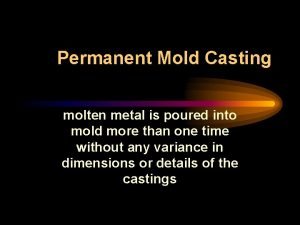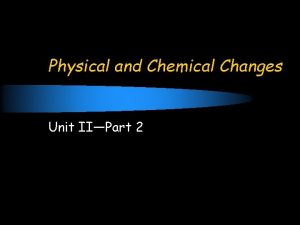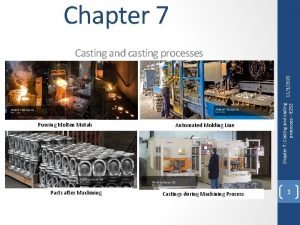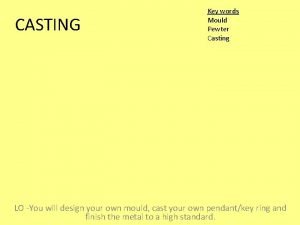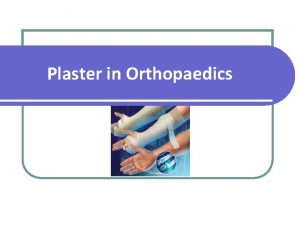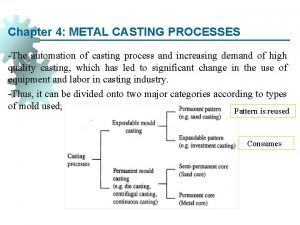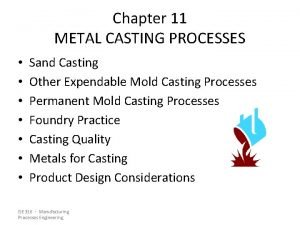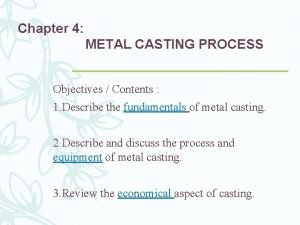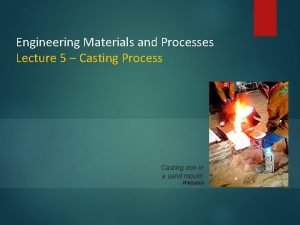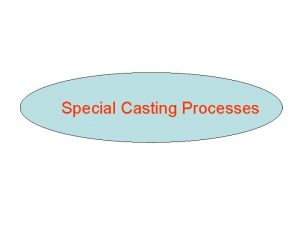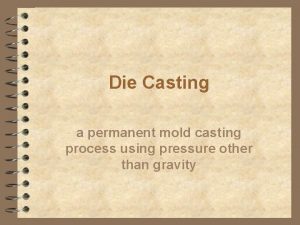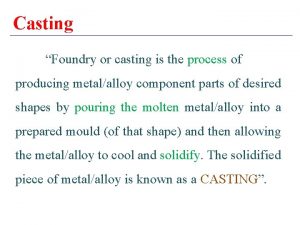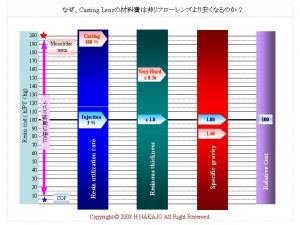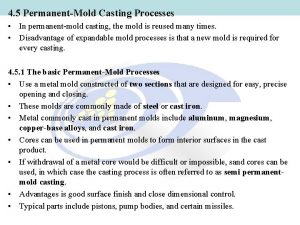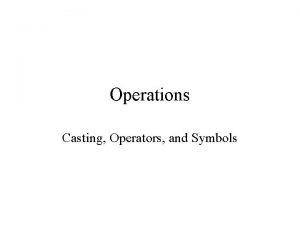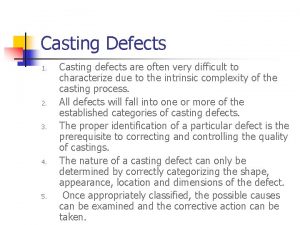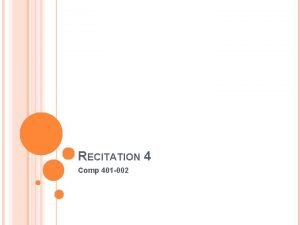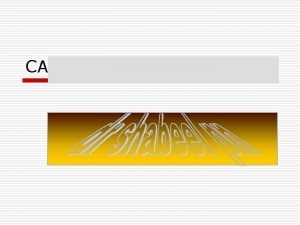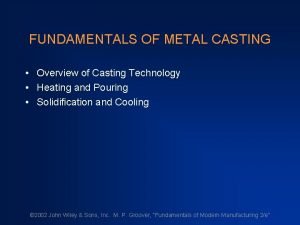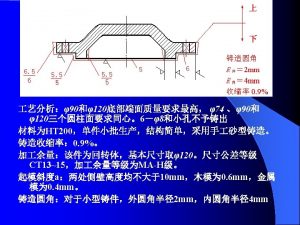CASTING PROCESS Casting is the process of pouring








































- Slides: 40

�CASTING PROCESS : � Casting is the process of pouring molten metal into the previously made cavity to the desired shape and allow it to solidify. � STEPS Ø Ø Ø INVOLVED IN MAKING CASTING making pattern and core box Making mould Melting and pouring the metal Cleaning Inspection and testing Reclaiming sand

PATTERN Ø Ø 1. 2. 3. 4. 5. 6. 7. 8. Pattern is the solid form that used to make the mould. Types of pattern Loose pattern Gated pattern Match plate pattern Cope and drag pattern Pattern devices Shell pattern Built up pattern Lagged up pattern

LOOSE PATTERN � Not connected to other patterned or mounted on a plate. � Classified in to 1. Solid piece pattern 2. Self core pattern 3. Split pattern 4. Loose piece pattern Ø

GATED PATTERN � They are number of loose pattern connected with gatting system. � Reduce moulding time. � Extra cost for operation of separating individual casting. Ø COPE AND DRAG PATTERN � Used for medium and large size casting. � Separate pattern plates are made for cope and drag halves. Ø

PATTERN DEVICES � When the size of casting is too large and number casting to produce is only two or one then full pattern prove uneconomical. � In such case sweeps, segments, skeletons and follow boards are used. Ø

SHELL PATTERN Ø U-used mostly for piping work Ø C -consist of a thin cylindrical or Ø curved metal piece Ø BUILT UP PATTERN � Intricate patterns are built op by joining segments of wooden strips. � These segments are cutting strip of wood to the curvature required and gluied together to form the desired size of the pattern. Ø

MATCH PLATE PATTERN � Designed to work with match plate moulding machine for high production rate. � They are expensive. � Accuracy is more than those made by hand moulding. Ø � LAGGED UP PATTERN Used for cylinders, pipes and columns. �

PATTERN MATERIAL � 1. 2. 3. 4. 5. Following material can be used for pattern making Wood Metal Plastic Plaster Wax

WOOD � Most commonly used � Readily available � Worked easily � Can join by glue � Can preserved with shellac � Repaired easily � Hard , strong and less likely to wrap

METALS � Used in mass production � Can hold dimension and don’t wrap � Are not effected by moisture � More wear resistance � Can get good surface finish � Used: aluminium, white metal, cast iron, brass , mild steel � Are expensive as compare to wooden � Heavier

PLASTICS � � � Good wear resistance Are not effected by moisture Give good surface finish Light in weight Because of glossy surface pattern withdrawn is easy Can’t withstand shock PLASTER • Easy to cast • It is brittle • It expands on solidifications

Wax � While removing pattern there is no chance of damaging the mould cavity � Wax pattern is not taken out from the mould � Mould is inverted and heated � Wax gets vapourised

Pattern Allowance � Draft allowance � Machining allowance � Shake allowance � Distortion allowance � Shrinkage Allowance

Ø DRAFT ALLOWANCE • While removing the pattern from the mould the vertical faces are continuous contact with the mould • Taper provided to facilitate its withdrawal easily • Commonly applied 10 to 30

Ø MACHINING ALLOWANCE � Provided to take care of the surface finish and dimensional requirement of casting. Depends on material of the casting , size, and surface of casting, the method of casting and moulding. CI : – 3 to 10 mm on s/f CS: - 4 to 12 mm Non ferous: - 5 to 15 mm � �

SHAKE ALLOWANCE � Cause : rapping of pattern before they are withdrawn. � A allowance is applied to the dimension which are parallel to the parting plane. Ø

DISTORTION allowance � Certain casting like large flat plates and V OR U shape castings have tendency to wrap or distort on cooling � Cause: uneven metal thickness

SHRINKAGE ALLOWANCES � Liquid shrinkage � Solidification shrinkage Ø can make good by gating and risering system � Solid shrinkage Ø Can’t remove easily Ø Can compensated by making the pattern larger than the requires

Colour coding of pattern � Shellac paints are used � It gives protection � colour identifies the feature of the pattern

� Black – unfinished s/f on a casting � Red – finished s/f on a casting � Yellow – core prints � Blank – parting s/f ces � Red/Yellow stripes – seats for loose pieces.

Moulding � It is defined as a cavity in which molten metal is poured and allowed it to cool so as to produce desired product. � It is formed with the help of pattern and mixture of sand in to the mould box. � The process of making mould is known as moulding. � It is mostly made from heat resisting material like sand clay.

MOULDING SAND Ø According to use of sand it classified as Green sand � Contain : 15 -25 % clay , 6 -8%water � Used to produce small to medium size mould Ø Dry sand � It is the green sand that has been dried after preparing the mould � Give strength to mould � Used for large casting Ø

Loam sand � Contain 50% clay � Used for heavy casting with the help of sweep and skeleton pattern Ø Parting sand � Stickness � Contain : clay free dry silica sand, sea sand , parting compound Ø

Facing sand � Made of silica sand clay without addition of any used sand � Thickness: 20 to 30 mm Ø Backing sand � Consist of old repeatedly used mould sand � Reduce cost Ø

Core sand(oil sand) � Silica sand mixed with core oil � Used: for making larger cores. Ø

PROPERTIES OF MOULDING SAND Strength Should have adequate strength in its green , dry and hop state � It is measured in tension, compression and shear. � Depends: grain size and shape : moisture content : density of sand Ø Adhesiveness : � Attach itself to another body � Readily attached with sides of moulding box so that it does not fall � Depends on binder used Ø �

Permeability � Natural porosity of sand which will permit steam and other mould gases to escape. � Higher if clay content is less and grain size is large. Ø Refractoriness � Ability to withstand the temperature of liquid metal. � Measured by sinter point. Ø

Flowability � Ability to flow all around the pattern and take desired mould shape. � Increase as clay and water content are increased. Ø Collapsibility � Sand should collapse after the casting is solidified. � The property is very important for core sand which forms interior detail of casting. Ø

Porosity or permeability � It is the measure of sand’s ability to permit air to flow through it. � It is desired to allow gases, vapours escape from mould.

CORE AND CORE MAKING Core To produce inside detail, recess , cavity in a casting a suitable solid mass should be placed in the mould to prevent the metal from pouring in these place resulting in a cavity. � This solid mass in a mould is called core. Ø � Core material Sand : green sand : Dry sand Ø metal Ø Ø

Ø 1. 2. 3. 4. Method of core making Preparation of core sand mix Core making Core drying or backing Core finishing

MOULDING PRACTICE Green sand moulding � They are moulds by using conventional clay sands and poured with the moulds in wet sand. � Composition : 60% floor sand, 30% new sand, 10% coal dust. � Least expensive method of moulding. � Lack of permeability and strength due to moisture. Ø

How to prepare a mould for green sand moulding…? ? ?

Ø Dry sand moulds � They are completely dried in ovens before pouring. � Composition: 53% floor sand, 42% new sand, 5% horse manure or saw dust and blinders like flour, resin, molasses or clay. � Used for large casting requiring strong mould. � More dimensional accuracy compared to green sand moulding. � They are more susceptible to distortion and hot tears , longer production cycle.

Process of preparation of the dry sand mould…. .

Ø � � Loam sand moulds They are built up with unburnt bricks or large cast iron parts and plasters with loam mortar. Chopped straw may be added for strength and cow dung added to enhance workability. Large cylinders , heavy bells, chemical plant pans are cast using loam sand moulds. It is time consuming.

Carbon dioxide moulds The mould is prepared by ramming clean sand mixed with sodium silicates around the pattern. � The carbon dioxide is added to harden the mould. � It has high accuracy and good surface finish. � Reduce the manual work and cost. Ø �

Ø Floor moulding � The moulding is done on the foundry floor , is known as floor moulding. � It is used for medium and large size casting. � Metal flask is used for holding the sand.

Ø Pit moulding � Very large moulds are made in pits below the foundry floor, is known as pit moulding. � The pit acts as the drag part of the mould while a separate cope is used above it. � The sides of pit are lined with bricks while its bottom is covered with a thick layer of cinders. � Reduces the efforts and cost of casting.

PREPARE A MOULD
 Graphite permanent mold casting
Graphite permanent mold casting Jose feliciano listen to the falling rain
Jose feliciano listen to the falling rain Pouring milk on your oatmeal physical or chemical
Pouring milk on your oatmeal physical or chemical Britelness
Britelness Sand mold casting
Sand mold casting This is the centerpiece of any pouring station
This is the centerpiece of any pouring station Separating sand from gravel chemical or physical change
Separating sand from gravel chemical or physical change Concrete pouring
Concrete pouring Liquid is pouring into a container at a constant rate
Liquid is pouring into a container at a constant rate Classification of casting
Classification of casting Pewter casting process
Pewter casting process Principles of plaster of paris
Principles of plaster of paris Cold shot defect
Cold shot defect Centrifugal casting process steps
Centrifugal casting process steps Lost wax process suppliers
Lost wax process suppliers Introduction of casting
Introduction of casting Shape casting
Shape casting Vacuum die casting advantages and disadvantages
Vacuum die casting advantages and disadvantages Fettling process in casting wikipedia
Fettling process in casting wikipedia Hát kết hợp bộ gõ cơ thể
Hát kết hợp bộ gõ cơ thể Lp html
Lp html Bổ thể
Bổ thể Tỉ lệ cơ thể trẻ em
Tỉ lệ cơ thể trẻ em Voi kéo gỗ như thế nào
Voi kéo gỗ như thế nào Tư thế worm breton là gì
Tư thế worm breton là gì Hát lên người ơi
Hát lên người ơi Môn thể thao bắt đầu bằng chữ đua
Môn thể thao bắt đầu bằng chữ đua Thế nào là hệ số cao nhất
Thế nào là hệ số cao nhất Các châu lục và đại dương trên thế giới
Các châu lục và đại dương trên thế giới Công của trọng lực
Công của trọng lực Trời xanh đây là của chúng ta thể thơ
Trời xanh đây là của chúng ta thể thơ Cách giải mật thư tọa độ
Cách giải mật thư tọa độ Làm thế nào để 102-1=99
Làm thế nào để 102-1=99 Phản ứng thế ankan
Phản ứng thế ankan Các châu lục và đại dương trên thế giới
Các châu lục và đại dương trên thế giới Thể thơ truyền thống
Thể thơ truyền thống Quá trình desamine hóa có thể tạo ra
Quá trình desamine hóa có thể tạo ra Một số thể thơ truyền thống
Một số thể thơ truyền thống Cái miệng xinh xinh thế chỉ nói điều hay thôi
Cái miệng xinh xinh thế chỉ nói điều hay thôi Vẽ hình chiếu vuông góc của vật thể sau
Vẽ hình chiếu vuông góc của vật thể sau Nguyên nhân của sự mỏi cơ sinh 8
Nguyên nhân của sự mỏi cơ sinh 8
